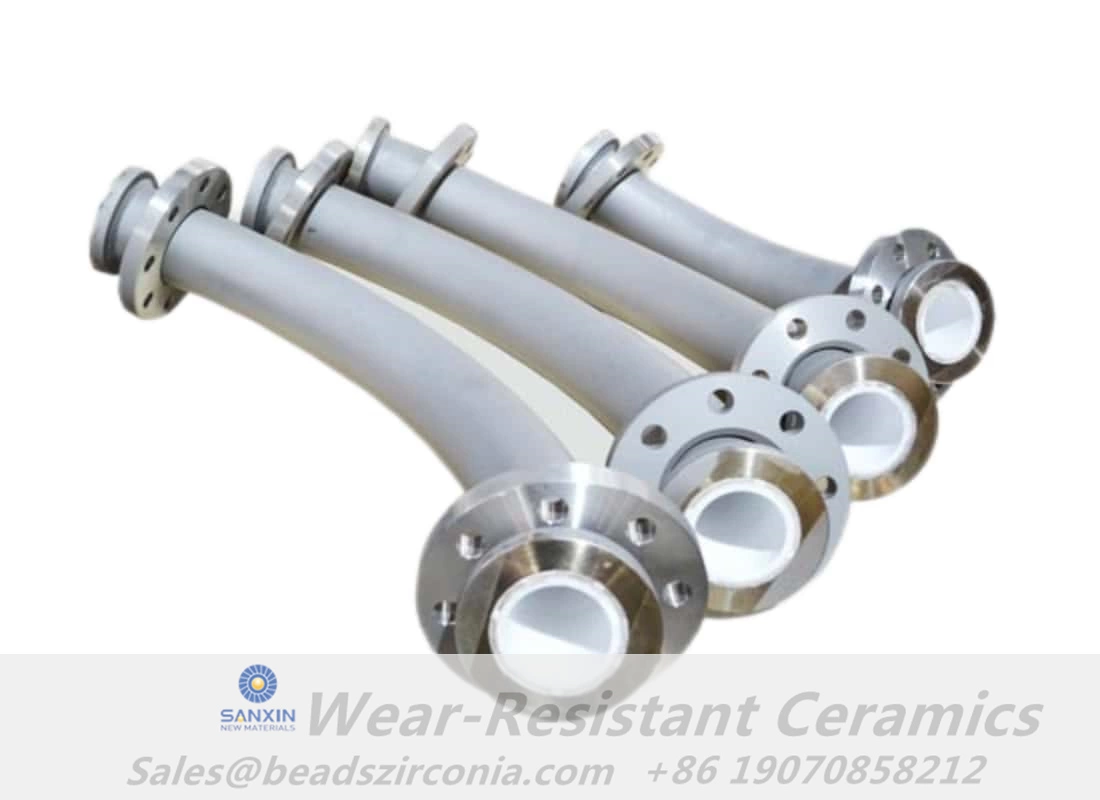Wear-resistant ceramic composite pipes, also known as steel pipes lined with wear-resistant ceramics, showcase numerous advantages by effectively combining the high strength, excellent toughness, impact resistance, and good welding performance of steel pipes with the high hardness, wear resistance, corrosion resistance, and heat resistance of alumina ceramics. This synergistic combination overcomes the shortcomings of low hardness in steel pipes, poor wear resistance, and inferior toughness in ceramics, optimizing the configuration to unleash the full potential of wear-resistant ceramic composite pipes.

Based on the form of the ceramic lining, wear-resistant ceramic composite pipes can be broadly categorized into four types:
Ceramic Tile Lining:
Advantages: Exceptional wear resistance with Mohs hardness reaching 9.0 (equivalent to HRC90 and above).
Application: Ideal for industries conveying abrasive media such as metallurgy, electricity, mining, and coal.
Self-Combustible Composite Ceramic:
Advantages: Suitable for high-temperature environments, corrosion-resistant, and has extended lifespan.
Application: Effective for crafting large-diameter dust collection pipes.
Spot Welded Card Wear-Resistant Ceramic:
Advantages: Resilient against temperatures up to 750°C, corrosion-resistant, and long-lasting.
Disadvantages: Complex production process, longer production cycles, and higher costs.
One-Piece Molded Wear-Resistant Ceramic Composite Pipe:
Advantages: Smooth inner surface, excellent sealing, high-temperature resistance, and prolonged lifespan.
Disadvantages: Lengthy production cycles and higher costs.
Outstanding Wear Resistance:
The inner layer, composed of alumina ceramics (a-AL2O3), boasts a Mohs hardness of 9.0, ensuring exceptional wear resistance in conveying abrasive media.
Low Operational Resistance:
Due to the smooth inner surface, the ceramic composite pipe exhibits lower resistance than any metal pipe, resulting in improved operational efficiency.
Corrosion Resistance and Anti-Scaling:
The ceramic lining is neutral (AL2O3), providing resistance against acidic, alkaline, and seawater corrosion, along with anti-scaling properties.
Temperature and Thermal Shock Resistance:
The use of alumina ceramics (AL2O3) in the inner lining ensures stable crystalline structure, allowing the composite pipe to operate normally within the temperature range of -50°C to 500°C.
Cost-Effective Engineering:
Lightweight and reasonably priced, wear-resistant ceramic composite pipes present a cost-effective solution for various industries.
Easy Installation and Construction:
The lightweight nature and excellent welding properties of these pipes facilitate convenient installation using methods like welding, flanges, and quick connections, reducing overall installation costs.
Patch-Type Wear-Resistant Ceramic Composite Pipe:
Advantages: Simple production process, short production cycles, and relatively low costs.
Disadvantages: Requires careful handling during transportation and installation to prevent ceramic detachment upon impact.
Spot Welded Card Wear-Resistant Ceramic Composite Pipe:
Advantages: Endures temperatures around 750°C, suitable for large-diameter dust collection pipes, and offers long-term corrosion and wear resistance.
Disadvantages: Complex production process, longer production cycles, and higher costs.
One-Piece Molded Wear-Resistant Ceramic Composite Pipe:
Advantages: Smooth inner surface, good sealing, high-temperature resistance, and extended lifespan.
Disadvantages: Lengthy production cycles and higher costs.
Self-Combustible Wear-Resistant Ceramic Composite Pipe:
Advantages: Simple production process, short production cycles, and relatively low costs.
Disadvantages: Potential internal roughness and gaps in curved sections, posing long-term usage risks even with post-sintering repairs using refractory mud.
In conclusion, industrial and mining enterprises can select wear-resistant ceramic pipes based on their specific production needs, considering factors such as cost-effectiveness, wear resistance, and production complexity. Sanxin New Materials stands ready to customize various models of wear-resistant ceramic composite pipes according to customer requirements and industry standards.

Submit your demand,
we will contact you ASAP.

Sanxin New Materials Co., Ltd. focus on producing and selling ceramic beads and parts such as grinding media, blasting beads, bearing ball, structure part, ceramic wear-resistant liners, Nanoparticles Nano Powder

